Mega engineering Cities at See
Discovery Channel Mega engineering Cities at See.
Click here to visit our Youtube channel
Discovery Channel Mega engineering Cities at See.
Click here to visit our Youtube channel
By Alina Dizik
BBC
September.28.2014
When Soren Terkelsen moved to a houseboat with his wife and two young children seven years ago, he wasn’t prepared for a front-row seat of Copenhagen’s winter storms.
“All of a sudden the ship turns into a steel thing that you cannot control,” said the 44-year-old. “We were completely new to this and had a lot of surprises.”
For Terkelsen, taking care of the M/S Arno, a 50-year-old boat that was refurbished into a family home, wasn’t immediately intuitive. In fact, there was much to learn about the new lifestyle.
The boat requires a new coat of paint with the rust scraped off every few years, the septic tank needs to be emptied regularly and there are mooring restrictions that dictate where he can keep the vessel.
Still, living close to the city without the chaos, while enjoying the serenity unique to waterside living—like watching geese and other water birds fly past — is hugely rewarding, he said.
“I really love it,” said Terkelsen, who recently started Copenhagen Boats, a boat-rental business.
For those who’ve long dreamed of living on the water, owning a houseboat is within reach. Many refurbished boats are on the market in waterfront cities including Seattle, San Francisco, Amsterdam, Stockholm and Copenhagen. And, new luxury communities are in various stages of development in Dubai, the Maldives and Miami. Houseboat prices can run from $200,000 into the millions, depending on the location and the level of luxury.
Architects say homes that float on the water can rise and fall with the tides, keeping buyers safe from flooding and rising water levels due to climate change. “It’s a unique lifestyle,” said Rick Miner, a Seattle-based real estate broker who specializes in floating homes and has lived in one for 23 years.
How to find it
After 25 years spent working in the hospitality industry in Vancouver, Canada, Ben de Vries knew he wanted to return to Holland and live in one of Amsterdam’s famous houseboats. But finding a boat wasn’t easy.
In cities like Amsterdam, licensed boats docked within city limits can be difficult to find because there are so few lots along the city’s waterways. After a long search, de Vries bought an old boat in 2001 for €120,000 ($92,850), which didn’t quite fit his idea of a dream houseboat because it was cramped and in need of an upgrade.
But, the old boat was well worth the price, he said, as the purchase included the valuable docking space license, or ligplaats, which in Amsterdam is sold together with the boat. Places to moor the boat in this Dutch city are fixed and cannot be changed to a different location, similar to purchased land. De Vries eventually purchased a new boat for €110,000 ($85,115) to put in the same space.
The hassle was worth it. While some houseboat communities on the city’s most popular canals can be loud, De Vries says he lives in a quieter part of the city and enjoys the diversity of his houseboat community. “They are usually interesting people that live on houseboats,” he said.
He also loves being close to nature. “I see big fish swimming around,” he said. “You’re more exposed to the elements.”
Due to limited docking space, competition for house boats is fierce in most markets, according to Koen Olthuis, founder of Waterstudio, an architecture firm in Deft, Holland that specializes on over-water projects.
Miner says that only six or seven boat properties per year are available for sale in Seattle and range from $700,000 to $1 million. By comparison, in Amsterdam, with an estimated 2,500 houseboats, there are more properties for sale and small older boats can sell for €200,000 ($154,750).
Finding a houseboat on your own can be difficult, so it is advisable to find a real-estate agent that specialises in houseboat sales. In the Maldives, for instance, Christie’s is selling 185 new floating villas, which start at $1 million and are in the first phase of completion, said Olthuis, who helped create the project.
Fees and maintenance
If you’re thinking of taking the plunge, there are some financial considerations to take into account.
The newest floating homes are built on a hollow concrete barge that can be towed to other locations but can’t be moved independently. But, because many floating homes and houseboats aren’t equipped with the engines, mechanics or navigation systems of boats, upkeep costs can be lower than a fully functioning water vessel of a similar size.
Monthly upkeep of your houseboat can cost from $200 to $600 for mooring fees and maintenance. Most owners pay monthly homeowner dues that cover water, sewer and dock maintenance. Those who own their docking spot, don’t pay a monthly mooring fee.
Houseboat owners are required to pay personal property taxes similar to home ownership on land. And, many houseboat communities also provide parking for homeowners as part of the monthly dues. But, in some areas, the saltwater can eat away at the floating home and require expensive upkeep well into the thousands of dollars, so budgeting for longer term, one-off or occasional expenses is also a good idea. When getting a mortgage, insurance in a must and is only slightly higher than homeowners insurance on land, mostly due to more possible weather damage. In the US, houseboat insurance averages about $1,500 annually.
Life on the water
If you think a houseboat will provide solitude, think again. Floating homes have their own neighbourhoods and provide a sense of community with other owners because they are rarely moved from one place to the next.
People “don’t realize how similar it is to normal housing,” said Olthuis, whose firm focuses entirely on overwater properties. “People still think it’s something futuristic.”
However, some of the comforts of home differ and require some adjustment. For one, bringing groceries or items back to the boat is often an acquired skill because you need to walk along a jetty. Odd jobs around your houseboat will also be different to those on land. A septic tank filled with used water needs to be properly emptied and cables that attach the boat to land must be checked frequently to prevent a boat coming loose during high winds.
Decorating is also a unique consideration. Some regular furniture can be an odd fit into the houseboat’s curved rooms, says Terkelsen, which means furnishing it could be more interesting — but more expensive — than a house on land. Some companies including the US-based Bradd and Hall specialize in furniture in marine settings.
How to finance it
Financing a home on the water is different than purchasing a home on land.
In the US, smaller banks located near houseboat communities such as those in the Northwest will help buyers get a mortgage, but most homes are bought for cash, said Miner. With a mortgage, most boat purchases require a 20% down payment, he said. Such mortgages require special inspections that can cost up to $800 and involve a dive survey of the outside part of the home, which is a cost covered by the buyer and should be factored into closing costs.
In Amsterdam, to close on sale, boats need to be examined in a shipyard outside of the water. Not all banks around the world offer houseboat mortgages. Instead, buyers may need to take out a secured loan, which is similar to a mortgage and gives more favourable terms because the borrower pledges collateral for the loan.
An added return
With so many curious travellers, one perk to owning a houseboat is that they are easy to rent out.
This year, Terkelsen and his family moved back on land to start renting out their Copenhagen houseboat online. Bookings are already filled for the next three months, providing a healthy income stream.
Renting out a room on his Amsterdam boat also helps De Vries offset the extra expense of living on the water, while allowing him to share his love of the water with travellers. Guests enjoy the novelty of booking a room at Ben’s Boat and Breakfastand being only 10 minutes away from the center of town, said De Vries who rents one of his bedroom suites for €95 ($123) per night.
“It’s a rewarding business,” he said.

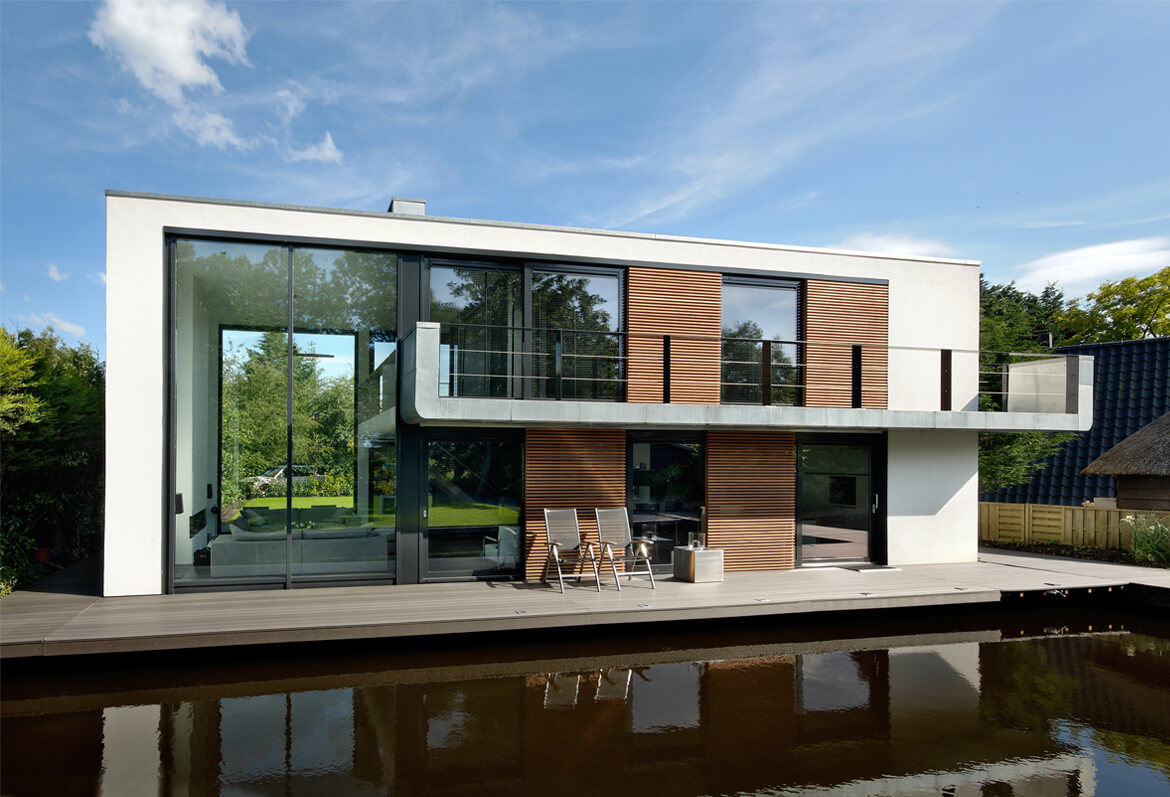
By Katherine Brooks
Huffington Post
September.18.2014
“The waterfront no longer places a limitation on city expansion, in fact it is the new frontier!”
So begins the description for “Sea Tree,” a futuristic nature reserve imagined by Netherlands-based architecture firm, Waterstudio. The wild design, still in the rendering phase, would bring floating steel structures to the shores of urban centers. And inside those steel towers, would be vegetated layers of habitable space, meant for both flora and fauna to flourish in spaces where land and wildlife is scarce.
 According to Waterstudio, Sea Tree would be built using the “latest offshore technology,” similar to that used in building oil storage towers in the open ocean. But instead of housing oil, the towers would play home to plant and animal species, working to reduce CO2 emissions along the way.
According to Waterstudio, Sea Tree would be built using the “latest offshore technology,” similar to that used in building oil storage towers in the open ocean. But instead of housing oil, the towers would play home to plant and animal species, working to reduce CO2 emissions along the way.
“Large oil companies will have the opportunity to give back by using their own intellectual property and resources to donate Sea Trees to a community in need,” Waterstudio wrote in a statement to HuffPost, “showing their concern and interest in preserving the distressed wildlife.” It’s a utopian endeavor, sure, but it offers already over-populated metropolises a chance to conserve wildlife within city limits.
The design, inspired by a project in Holland in which ecologists asked the firm to design a green oasis that could not be disturbed by humans, is meant for any waterfront, from riverbanks to sea shores. The height and depth of the structures would be custom constructed according to their specific locations, and would be anchored to the seabed with cables. The birds, bees, bats, and other small animals seeking refuge on a Sea Tree would be left untouched by humans, as would the plant life.
“Most of the innovation on land has been done already,” Koen Olthuis, Waterstudio lead designer and co-founder, explained to The Creator’s Project. “The truly innovative possibilities are found on water… The idea is that we cover the tower with fertile soil and then simply take our hands off of it and let nature do its thing. That’s the exciting part: to see what kind of effect such a green enclave will have.”
When asked when we could expect Sea Tree to become a reality, Ankie Stam at Waterstudio responded to HuffPost: “We’re now in the process of [finalizing] location (with city councils) and finance (with oil companies), for which we have several options. When this is completed we can start construction.”
Waterstudio sent us a selection of images that show the possibilities of Sea Tree. Let us know your thoughts in the comments. And for other floating architectural feats, check out Cristian Ehrmantraut’s prototype for a floating platform that filters the ocean and absorbs plastic.

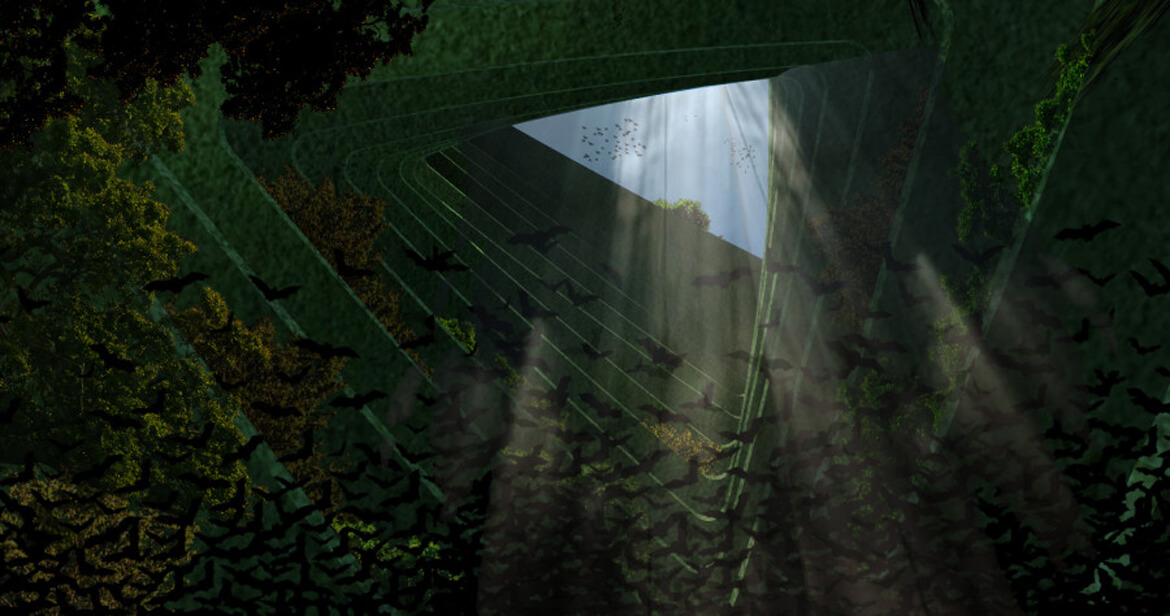
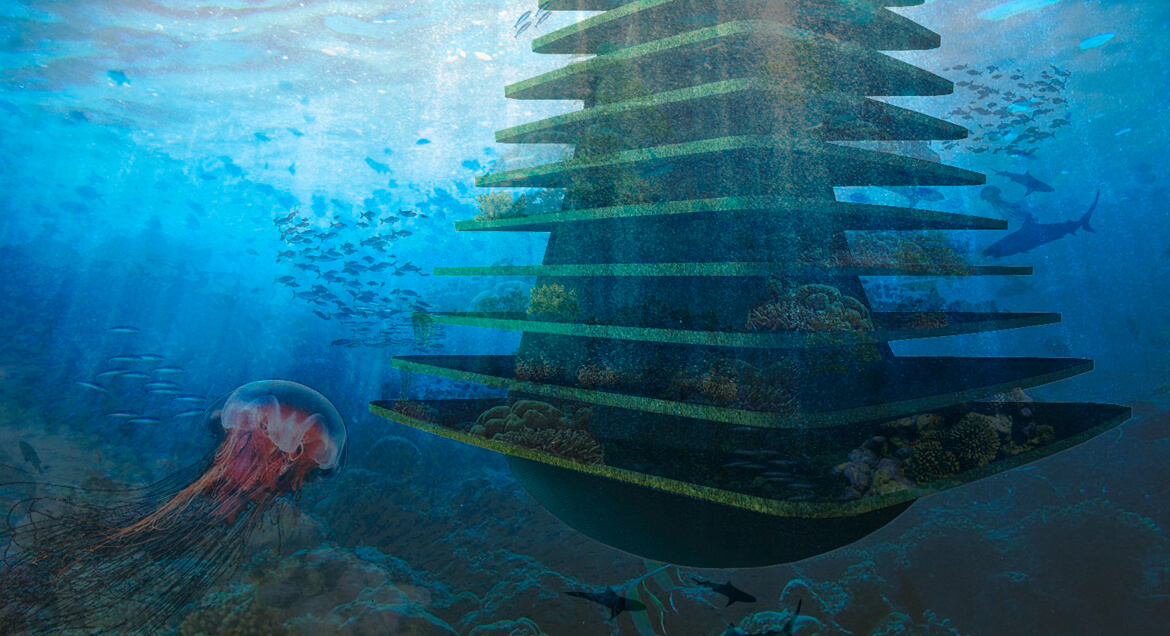
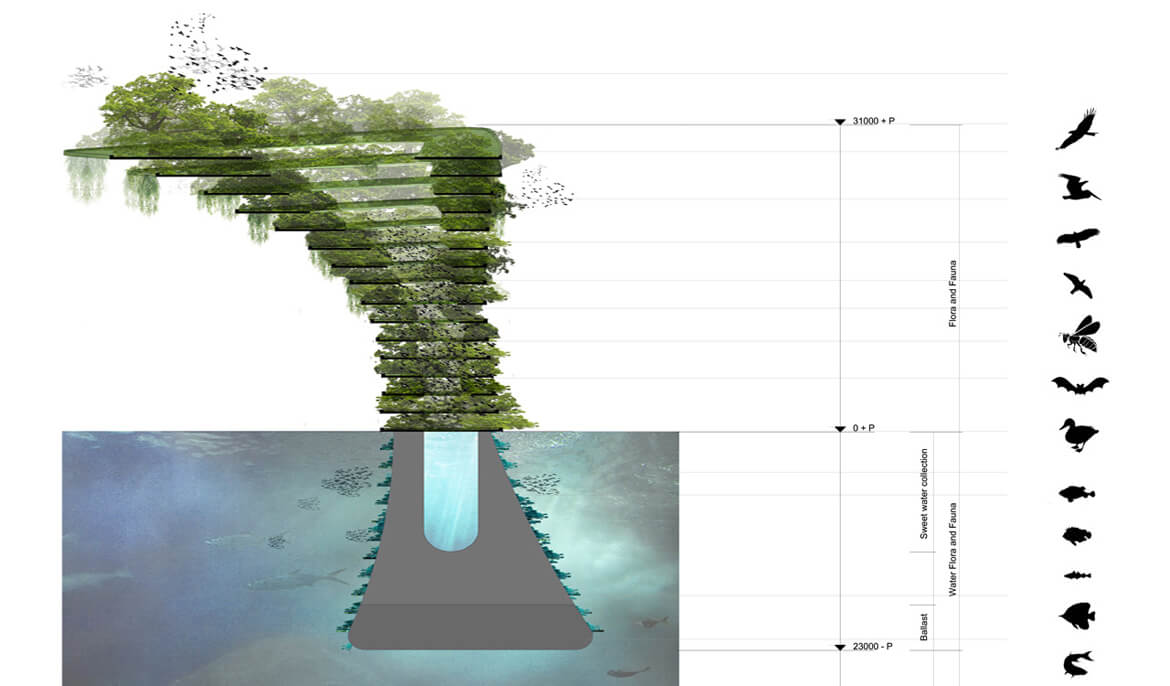
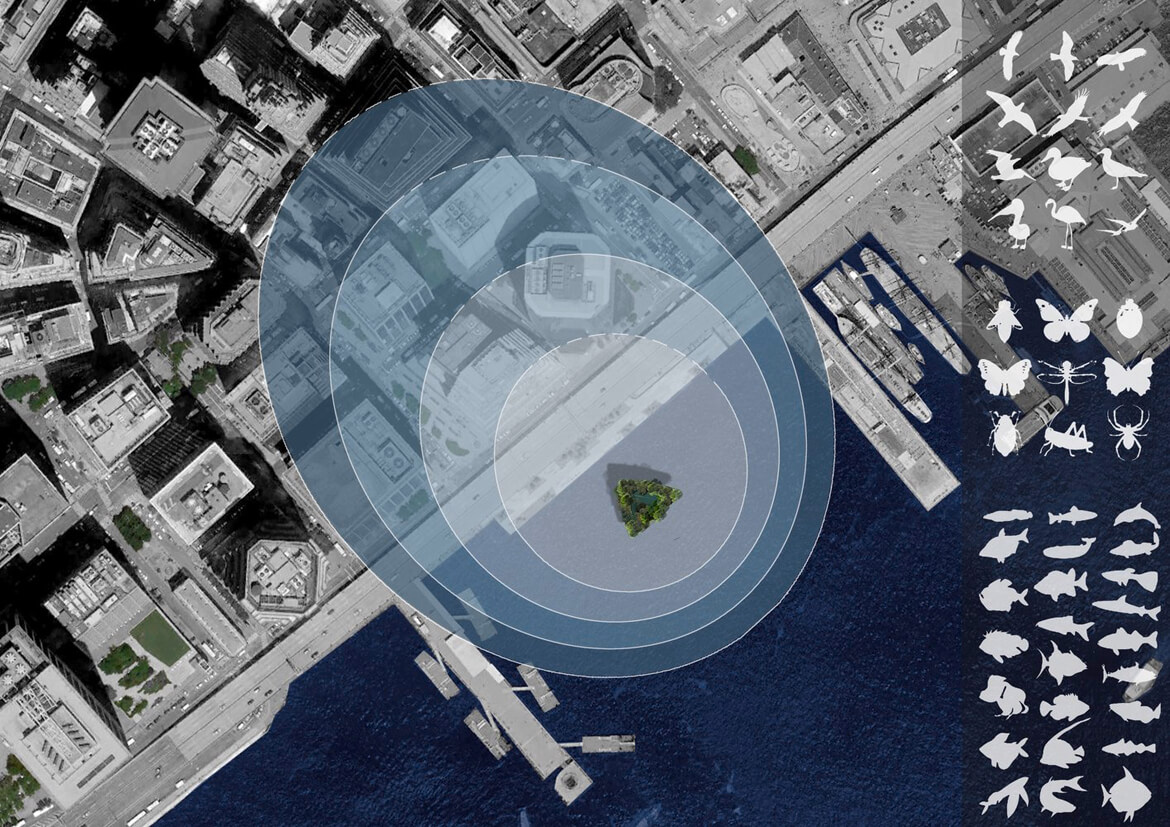
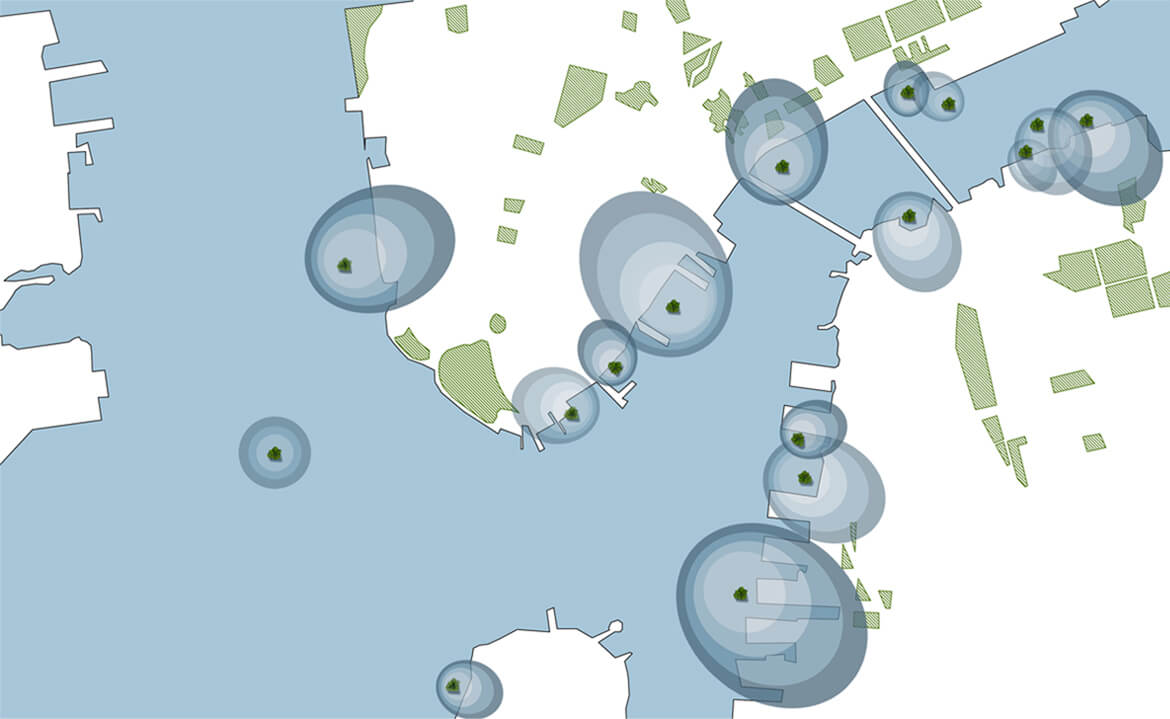
By Victoria Woollaston
Daily Mail
September.19.2014
With green spaces being replaced by building sites and large-scale developments around the world, architects are constantly looking for ways to replace them.
One such concept, devised by a team Dutch-based architects, uses towering structures built with layers of green space in which flora and fauna could live.
Called the Sea Tree, the structures would have space for birds and animals to live above ground, and would be bedded under the sea for fish and coral to inhabit.
‘Urbanisation and climate change put a lot of pressure on available space for nature in city centres,’ explained Waterstudio.
‘New initiatives for adding extra park zones to a city are rare.
‘Yet these kind of additional habitats for birds, bees, bats and other small animals could bring a lot of positive green effects to the environment of a city.’
Waterstudio’s concept is called the Sea Tree and it was designed to add high density, green spots to towns and cities.
According to designs, it would be a floating structure built using layers where animals and birds can live.
The structures would not accessible by man, and would be built using offshore technology and resources, similar to how oil storage towers are built and powered out at sea.
The idea is that large oil companies would donate a Sea Tree, and the trees could be built on rivers, seas, lakes and harbours.
The height and depth of the Sea Tree could also be adjusted depending on where it was placed.
To hold it in place, Waterstudio claims Sea Trees would be moored to the sea bed with a cable system.
Under the water, the Sea Tree would provide a habitat for small water creatures or, if the climate allowed for it, artificial coral reefs.
As well as providing a home for nature, the green structures could help reduce CO2 emissions produced by cities and towns.
‘The beauty of the design is that it provides a solution, and at the same time does not cost expensive space on land.
‘While the effect of the species living in the Sea Tree will affect a zone of several miles around the moored location.
‘For as we know, this floating tower will be the first floating object 100 per cent built and designed for flora and fauna.’
The firm said inspiration came from a project in Holland where ecologists asked them to provide habitats for animals which couldn’t be disturbed by people.
The cost for the Sea Tree design is estimated at €1 million (£786,100), and this would depend on water depth, mooring facilities and transport from construction site to the chosen city.
Further cost differences would depend on the preferred flora and fauna.
Waterstudio said it is in the process of finalising the location of the trees, and discussing costs with oil companies. Once these are complete, they will start construction.





By Fane Lozman
Miami Herald
September.10.2014
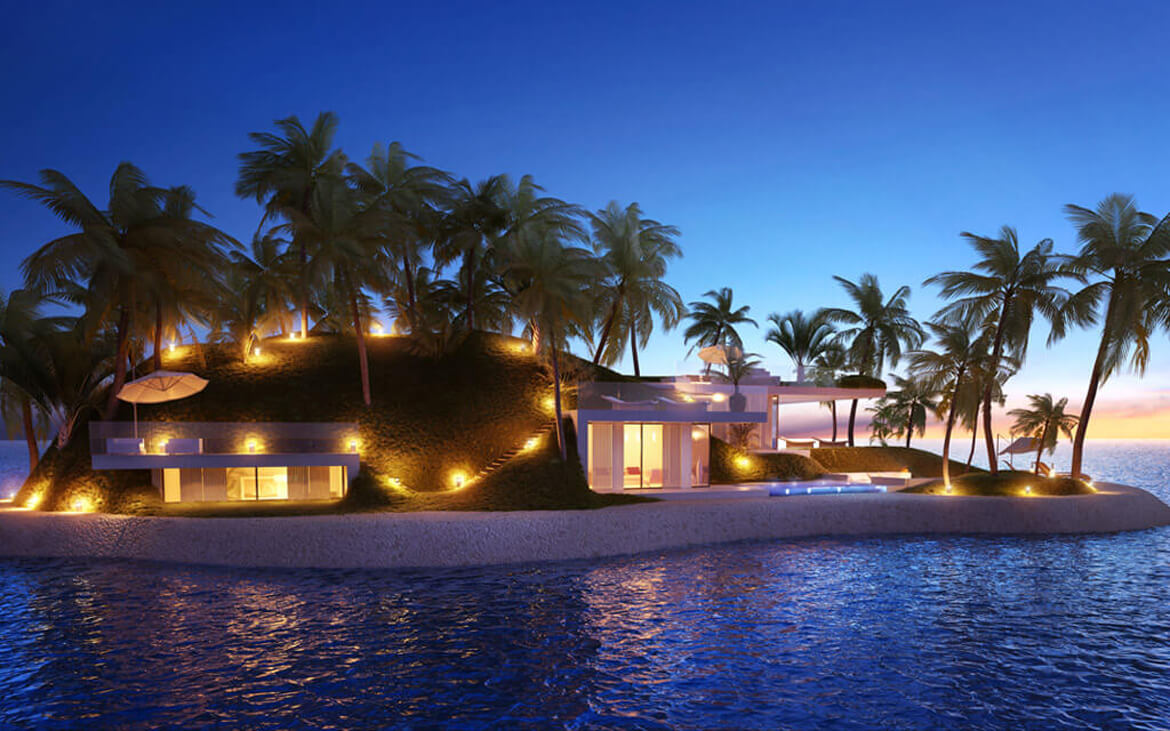
It is an unfortunate reality that those who currently live on Eastern Shores in Maule Lake will have to abandon their homes in the next 30 years because of rising tides. The only residents around Maule Lake will be the Amirillah floating islands, and any new developments built after Miami 21-like building codes are enacted.
The current Eastern Shores residents should be making plans now for where they will be moving once North Miami Beach condemns their residences for sea water intrusion. Instead, their fears are focused on the floating islands and reflect a total lack of knowledge about floating technology that has been proven over the last century.
Just like floating oil rigs moored to the ocean floor survive Category 5 hurricanes without being torn off their moorings, floating islands use similar technology. The land-based houses around Maule Lake would be swept clean off their concrete pads as the eye wall of a hurricane similar to Andrew made a direct hit, while the Maule Lake floating islands wouldn’t slide an inch off their permanent moorings.
Even more impressive is that these foam-cored, reinforced concrete islands are unsinkable, even after being pelted with 200-mph, windswept debris from the destroyed houses on shore.
The West Coast of the United States has thousands of floating homes that are a welcome addition to their communities in Washington, Oregon and California. The Maule Lake floating-island residences will introduce a new generation of floating homes to the East Coast. They will be completely self-sustaining and have the “greenest” footprint of any dwelling in South Florida.
The landlubbers whose attitude is that “I got to Maule Lake first and no one else should ever join me” forget one thing. The actual lake bottom is privately owned, and the submerged lands do not belong to those who are fortunate to live on its borders. Perhaps a 50-foot-high floating privacy screen running on the east side of Maule Lake would be soothing to these residents so they would not have to be jealous of their floating neighbors?
The floating islands will also help solve a simple reality that the political leaders of North Miami Beach can no longer ignore: New sources of tax revenue will be desperately needed to supplement the hidden pension demands of civil employees (i.e. police) over the coming years.
The 29 floating islands that will be assessed at $12.5 million each will bring in a staggering $363 million in new property assessments. This windfall for the city will be further magnified by the increased tax assessments for the Eastern Shores residents as their droopy neighborhood wakes up to become part of South Florida’s most unique residential community.
Like any new technology, whether it was the Wright brothers’ first airplane flight, or the $3 billon Perdido oil rig anchored in 2,438 meters of water in the Gulf of Mexico, there are “talking heads” that will refuse to accept the inevitable march of technology. It makes one wonder: How many Eastern Shores residents still have horse and buggies in their back yards?
FANE LOZMAN WON A PRECEDENT-SETTING VICTORY LAST YEAR AGAINST RIVIERA BEACH WHEN THE U.S. SUPREME COURT AGREED WITH HIM THAT HIS FLOATING HOME — WHICH THE CITY HAD SEIZED AND DESTROYED UNDER LAWS GOVERNING SHIPS AT SEA — WAS A HOUSE, NOT A VESSEL COVERED BY MARITIME LAW.
Joost Mollen
The creatorsproject
September.2014

Voor de mensen die het niet weten: een kamer vinden in Amsterdam is een ramp. De steden hebben nou eenmaal een ruimteprobleem en Amsterdam komt bijvoorbeeld al 15.000 huizen tekort. Maar niet alleen mensen lopen tegen dit woningtekort aan, ook planten en dieren hebben het zwaar. Urbanisatie en klimaatverandering leggen een druk op de beschikbare ruimte voor parken en natuur in stedelijke gebieden. Terwijl er al jaren hard wordt gewerkt aan het vergroten van het aantal woningen in de stad, zijn er helaas maar weinig projecten om nieuwe groene zones te creëren in steden. En dat terwijl parken vet relaxt zijn.
De ultieme oplossing voor dit probleem ligt, wat Waterstudio betreft, op het water. Het Nederlandse architectenbureau is gespecialiseerd in drijvende architectuur en ontwierp eerder al het drijvende ijshotel in Noorwegen en deze superstrakke drijvende villa. Nu wil Waterstudio een heus ‘flatgebouw’ op het water gaan bouwen die speciaal is ontwerpen voor dieren en planten in stedelijke omgevingen. Genaamd de Sea Tree, zal het de eerste drijvende constructie worden die een boost moet geven aan de ecologische systemen van steden. Chillen bovenop de Sea Tree is een no-go want de constructie is afgesloten voor mensen. Maar dat is geen ramp: alleen al kijken naar de ecotoren is genoeg. Hoofdontwerper en medeoprichter van Waterstudio Koen Olthuis nam de tijd om ons meer te vertellen over het project en wanneer we het groene flatgebouw ook in Nederland kunnen verwachten.
The Creators Project: Vertel, waar komt jullie fascinatie met water vandaan?
Koen Olthuis: Op het land had je alle innovatie al. Je deed als architect wat kleurtjes op de muur en stak het gebouw in een leuk vormpje en daar hield het op. Op het water lagen alle mogelijkheden. We zijn ons toen als eerste architectenbureau 100 procent op het water gaan focussen. Na een tijdje dachten we: dit moet niet alleen bij drijvende woningen blijven. We zijn toen gaan onderzoeken hoe steden door middel van drijvende concepten verbeterd kunnen worden. Nu zijn we bijvoorbeeld bezig met drijvende parkeerplaatsen, drijvende stadions en natuurlijk de Sea Tree, een constructie die een enorm positief effect zal hebben op de ecologie van een stad. We bouwen zonder ‘littekens’ omdat je al onze concepten zo weer weg kan varen. We lenen ruimte van de natuur en laten het weer achter zoals het daarvoor was.
Hoe is het concept voor de Sea Tree tot stand gekomen?
We werden door ecologen gevraagd om een plek te ontwerpen waar de natuur niet verstoord kon worden door mensen. We hebben toen op basis van technologie die door oliemaatschappijen wordt gebruikt een concept gemaakt waarin we de parken van een stad als het ware in de vorm van een boom op elkaar stapelen. Je kunt de Sea Tree het beste vergelijken met die Red Bull-autootjes die overal rondrijden. Dat is rijdende reclame. De Sea Tree is eigenlijk hetzelfde: het is een hele grote en drijvende groene advertentie voor de stad en de techniek van de oliebedrijven, één die laat zien dat het ook een positief effect kan hebben op de natuur en de stad. Het oliebedrijf behoudt het eigendom van de Sea Tree en de stad wijst een plek aan waar die mag drijven.
Hoe reageren de oliemaatschappijen en steden op het concept? Gaat de Sea Tree ook echt gebouwd worden?
De locatie in steden is geen probleem. We zijn bijvoorbeeld al in Singapore en New York geweest en daar was iedereen super enthousiast. Daarnaast bestaat de technologie ook al. Het punt is dat de bouw van zo’n ding nu al snel één a twee miljoen euro kost en voor dat geld hebben we oliemaatschappijen nodig die mee willen doen. Bij dat soort bedrijven heb je twee soorten partijen werken. Aan de ene kant heb je de mensen van de techniek die het helemaal geweldig vinden. Aan de andere kant heb je de mensen die gaan over de budgeten en advertisement en precies moeten weten wat de positieve en negatieve kanten voor zo’n onderneming zijn. Maar het is heel lastig in te schatten wat voor een effect de Sea Tree gaat hebben. Daar werken we nu aan. Toch zijn we heel positief en denken we dat alles binnen een jaar tijd geregeld kan zijn. Daarna duurt de bouwtijd maar vier tot zes maanden. Het is niets anders dan een drijvende betonconstructie waarop we de natuur haar gang laten gaan.
Als de Sea Tree er ook echt komt, hoe komt het er dan precies uit te zien? Kunnen we hem ook in Nederland verwachten?
De natuur is enorm veerkrachtig. Het idee is dat we de toren bedekken met voedzame aarde en dan de natuur haar gang laten gaan. We trekken onze handen er af en laten de natuur de Sea Tree zelf begroeien en bevolken. We zien dan wel wat voor een effect het gaat hebben. Het zou bijvoorbeeld de dalende bijenpopulatie een huis kunnen bieden, of een plek kunnen bieden voor vogels waarvoor nu geen ruimte is in de stad. De enige twee dingen die ons tegenhouden om dit bijvoorbeeld in Amsterdam te bouwen zijn in principe alleen de vergunning en het geld.
De Sea Tree is afgesloten voor mensen. Wat hebben we er precies aan behalve het ecologisch voordeel?
Ik kan me voorstellen dat als je in zo’n stad woont het enorm leuk is om naar het bouwwerk te kijken of er omheen te varen, je kunt er alleen niet zelf op gaan. Van een afstand denk je wooooww wat een enorme toren, terwijl het met een hoogte van 35 meter in de stad niet eens zo heel hoog zou zijn. Maar drijvend op het water ziet het er juist heel indrukwekkend uit. Het moet alleen geen geintje worden, zoals die enorme badeend die de wereld over ging. Wij willen ook echt een effect hebben.
U bent heel erg bezig om een plek te vinden voor het ecosysteem van de natuur in de stad. Wat denkt u dat een concept zoals de Sea Tree zegt over de richting waarin de mens de natuur stuurt? Is de Sea Tree een oplossing om de natuur een plaats te bieden in een snel urbaniserende wereld?
Nou oplossing, nee, daarvoor is het effect te klein. Als je werkelijk wilt dat de Sea Tree een effect heeft dan moet je er niet één maar gelijk dertig of veertig neerzetten, zoals we in New York bekeken hebben. Maar het geeft wel een hele duidelijke richting waar we naar toe moeten. Op de lange termijn zie ik niet voor me dat de hele wereld straks vol ligt met Sea Tree’s, absoluut niet, maar het zet mensen wel aan het denken over de mogelijkheden van de natuur op het water, zoals grote drijvende parken of drijvende akkers. De Sea Tree is een symbool voor de eerste stap in die richting. Het is als een enorm groen billboard dat naast een goede boodschap ook nog eens een daadwerkelijk effect op de natuur heeft. Dat is natuurlijk prachtig.




By Sam Becker
Cheatsheet business
August.2014
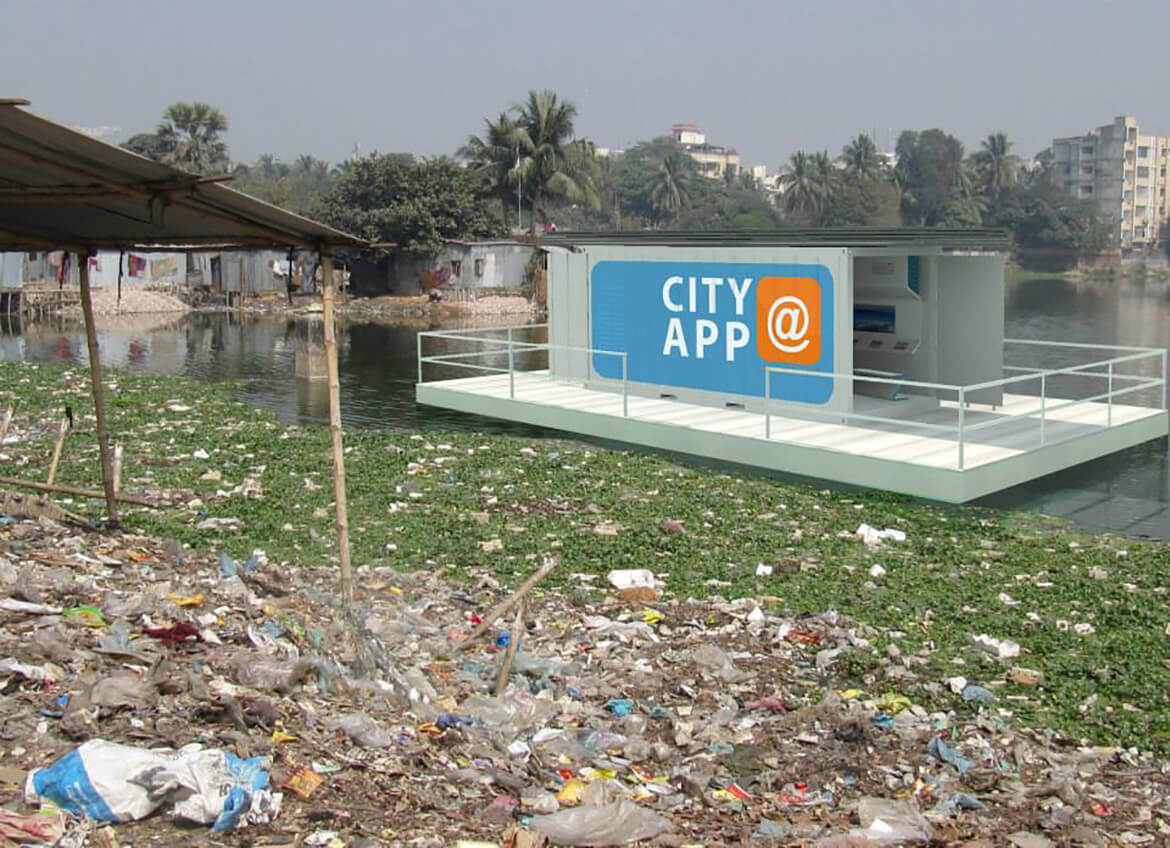
According to the U.N., approximately 40% of the world’s population lives relatively close to a coastline. Even more than that live in close proximity to rivers and lakes. Together, rivers, lakes, and the sea all offer a wide variety of conveniences, resources, and a method of transportation, making human civilization inherently tied to the water itself. As water has universally been used as a means of exploration and transport for millennia, naturally it makes a fitting tool to use for tackling some of the world’s modern problems, including poverty and medical and education issues.
The question was how to best utilize it. Well, we may have our answer.
One man is revolutionizing the way the world sees cities by bringing a bold new idea to the table. Instead of viewing the idea of cities as static, brick-and-mortar establishments, Koen Olthuis instead likes to imagine them as flexible and malleable — able to adapt to the shifting needs of its citizens. Olthuis has an architectural firm based in the Netherlands called Waterstudio, which has been hard at work creating, among other things, floating houseboats, floating hotels, and even underwater structures. But Olthuis’ true target is the persistent and widespread poverty that sits adjacent to many of the world’s waterways, and use them as a means to deliver help in the form of hospitals and schools.
His idea is called Floating City Apps, which are constructed from recycled shipping containers and built on floating, barge-like structures, ensuring that they are easily moved from place to place, depending on where they are needed. The name comes from the idea of adjusting the apps on a mobile phone according to a user’s needs; City Apps would be able to reconfigure the layouts of slums in the same way.
So, how exactly would Olthuis’ idea work in the real world? As the Floating City Apps blog explains, “first a slum is mapped and local problems are related to water potential in the slum. The Floating City App with the most impact or effect is selected. With the help of our network, licenses and local manager or entrepreneur is selected. The Floating City App will be transported from The Netherlands to the slum.”
After the physical structure itself is shipped to its end destination, local licensees would then take over . “Locally the floating foundation will be built from collected used PET bottles supported by a steel frame. The City App is placed on the function a business model for payed use of the Floating City App is executed in order to get a ROI for the investors. In case of any change in situation the City App can be reused relocated or sent back to The Netherlands.”
In a nutshell, the Floating City App functions as a small business, which is built in the Netherlands and shipped to wherever it is needed. It is then licensed to a local entrepreneur until it is no longer deemed necessary or wanted.
The idea itself is a bit unorthodox, but it does set the wheels in motion for some interesting business models, and could be a very effective way to strategically build in areas of need. In fact, in a way, Floating City Apps open up a route for entrepreneurs to engage the free market in an entirely new way — by offering public services like sanitation or education to places that may be severely lacking.
Imagine a City App anchored dockside near an under-served community that offers Internet access to those who have never had it before? Or even a floating medical center after a natural disaster? The potential applications are numerous, and the idea lends a whole new way to how architects, planners, and engineers can use the topographies of certain cities.
With other factors like climate change leading to impending sea level rises, Floating City Apps may become less of an out-of-the-box idea and more of a necessity in the near future. The idea appears to have merit, and there’s really nothing standing in the way of its feasibility. There are many cities and areas across the world that could benefit from the use of floating service centers. Olthuis himself notes during his TED Talk, seen above, that cities are still built the way they were hundreds of years ago, and engineers need to find a way to take advantage of the water and the space that it provides.
“They’re flexible, they’re reusable, and can work as instant solutions,” Olthuis said of his Floating City Apps. “And they can be much more than only housing. All kinds of functions we can use (them for). Islands, floating beaches, cruise terminal, floating rotating tower, floating roads, agriculture, even a complete floating forest.”
“Almost anything you can think of can also be done on the water,” he adds.
If even a fraction of those ideas are able to be successfully pulled off in the real world, Olthuis’s idea could, in fact, be world-changing. For cities that are located next to large bodies of water and that are densely populated — think locations in Asia or Europe — entirely new neighborhoods could spring up to alleviate congestion and density.
Of all the potential applications, perhaps the most exciting concept is that of floating agriculture. If food production can be brought to dense inner cities bordering bodies of water, fresh and more affordable food would become available to those who desperately need it. Even in America, imagine the advantages a floating corn farm in an inner-city bay would bring to local residents. Granted, there are a lot — a whole lot — of factors to consider. But think of the transportation costs that could be cut out by having a food resource ten minutes away from grocery stores, rather than thousands of miles, in America’s heartland.
Olthuis’s idea certainly is bold, if not ingenious. The next step, of course, will be to see if investors jump on board and if the concept can be put to practical use. Even if Floating City Apps take a long time to gain momentum and take to the waterways of the world’s cities, it’s the kind of thinking being displayed by Olthuis that will truly help change the world for the better.
With the challenges the world’s population is set to face in the coming decades and centuries, we’ll need all the radical ideas we can muster.
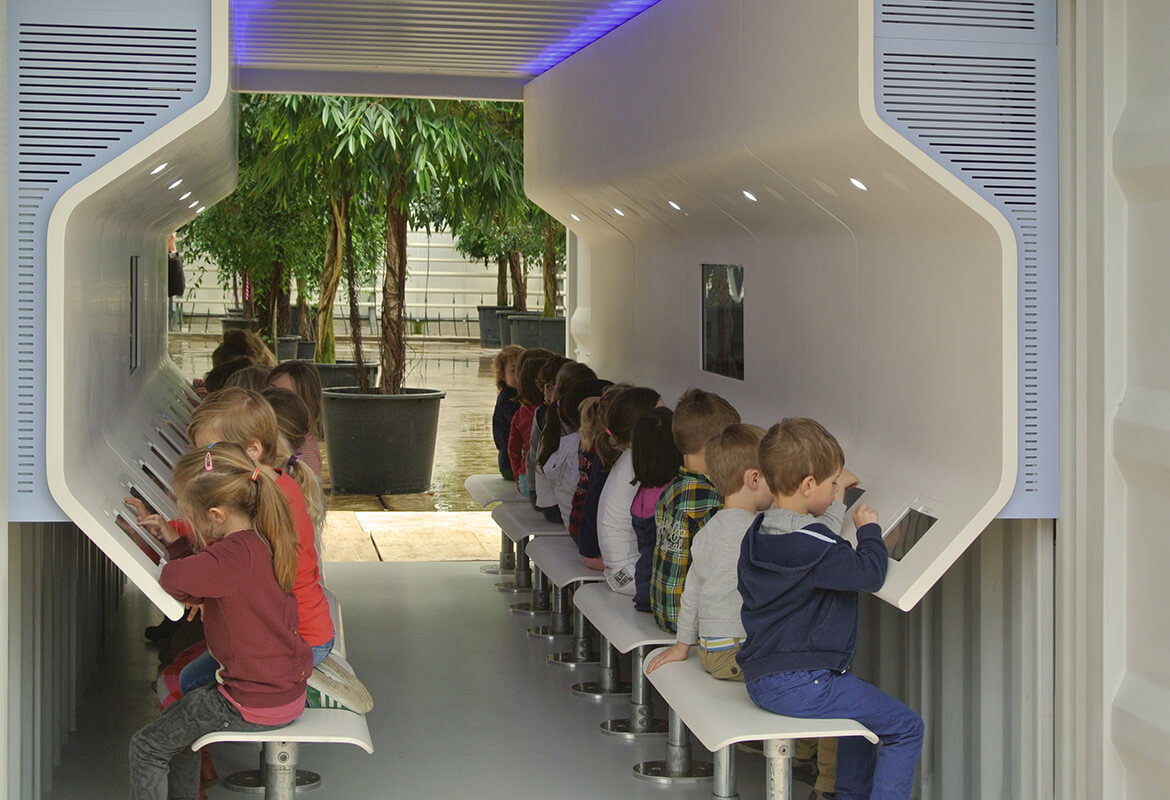
By Architectenweb
August.2014
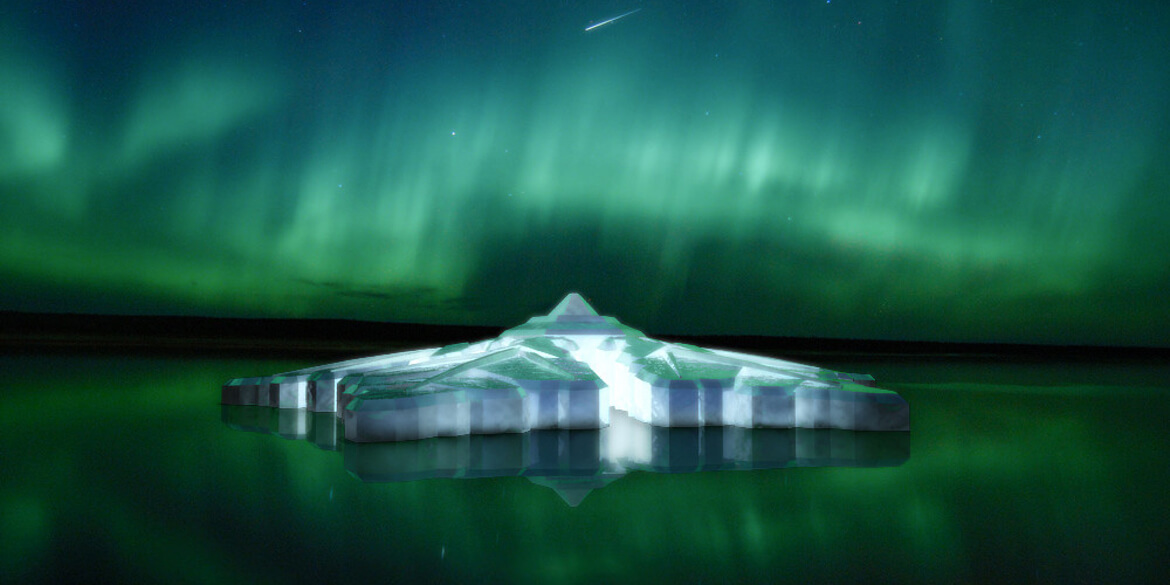
De kans is groot op een drijvend vijfsterrenhotel voor de kust van Noorwegen. De gemeente Tromsø, ontwikkelaar Dutch Docklands en architectenbureau Waterstudio.NL hebben een overeenkomst getekend.
Krystall Hotel moet het meest luxe hotel in het hoge noorden worden, als het aan Dutch Docklands ligt. Het hotel wordt ontworpen als een drijvend ijskristal en moet onder meer 86 kamers bieden. Na een intensief onderzoek naar mogelijke locaties en regelgeving is Waterstudio.NL gestart met het ontwerp van Krystall Hotel.
Het kleine maar bijzondere hotel moet de gasten een bijzondere ervaring met het noorderlicht bieden. Architect Koen Olthuis van Waterstudio.NL vertelt dat daarom een van de uitgangspunten is, dat het hotel een ‘glazen gebouw’ wordt: “Glasdaken voor de kamers zullen het onderscheidende kenmerk zijn”.
Stabiliteit
Het hotel wordt in delen in droogdokken gebouwd en op locatie geassembleerd. Het drijflichaam dat als basis dient zal erg groot zijn; dat zorgt tevens voor een stabiliteit waardoor werknemers en gasten geen beweging voelen. Stabiliteit wordt voorts versterkt door dempers, veren en kabels, maar ook de stervorm van het gebouw.
Het hotel zal geen vaste verbinding met het land hebben; gasten bereiken het Krystall Hotel per boot en ook alle verdere logistiek geschiedt via het water. Omdat het noorderlicht een belangrijke attractie wordt, komt het hotel ver genoeg uit de kust te liggen om de stadslichten van Tromsø geen storend element te laten zijn. De exacte locatie wordt nu onderzocht.
Overeenstemming
De internationaal opererende ontwikkelaar van drijvend vastgoed Dutch Docklands, Waterstudio.NL en de gemeente Tromsø hebben vorige week hun overeenstemming met een handtekening bezegeld. De bouw start naar verwachting half 2015; voor kerstmis 2016 moet het Krystall Hotel worden geopend en geëxploiteerd door een vijfsterren-hotelonderneming.
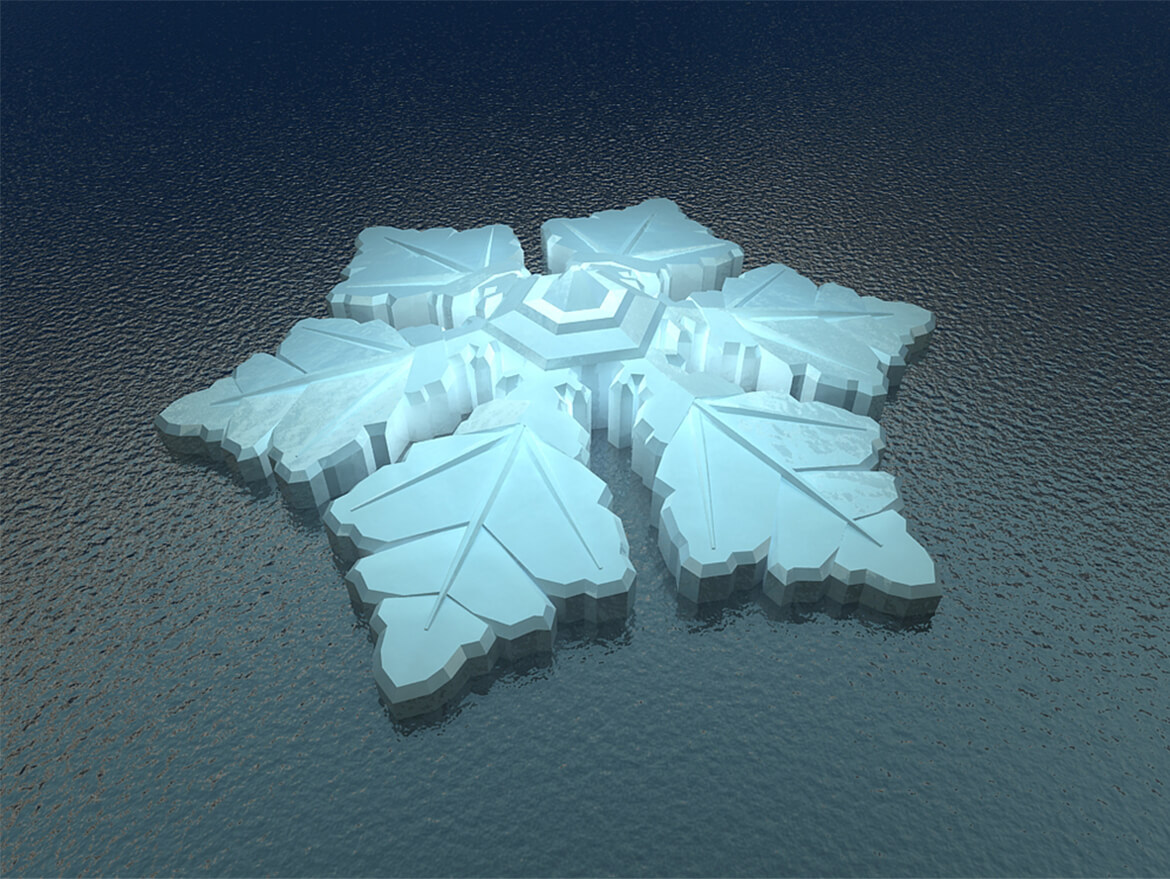
By Nordnytt
August.21.2014

Tromsø kommune har i dag signert en intensjonsavtale med selskapet Dutch Docklands om å bygge et flytende hotell utenfor byen.
Avtalen betyr at kommunen stiller seg positiv til at det femstjerners luksushotellet skal bygges i Tromsø.
Det nederlandske selskapet Dutch Docklands har planer om å bruke 500 millioner kroner på luksushotellet, som skal utformes som en flytende iskrystall, og inneholde 86 rom.
– Vi planlegger å bygge det mest luksuriøse hotellet i den nordlige delen av verden. Det vil bli et unikt femstjerners hotell som vil gi gjestene en opplevelse med nordlyset, men også andre aspekter av Norge og av denne delen av verden, sier Paul van de Camp administrerende direktør i Dutch Docklands.
Selskapet er eksperter på flytende konstruksjoner, og har tidligere blant annet bygget luksushotell på Maldivene.
For pengesterke gjester
Han sier at Tromsø ble valgt på grunn av historien sin, men også på grunn av at byen allerede har utbygd infrastruktur når det kommer til turisme.
– Er det et marked for et slikt hotell?
– Det vil bli et lite hotell, men i den øvre enden av skalaen. Det betyr at romprisene vil bli høyere enn det som allerede finnes på markedet i Tromsø. Vi retter oss mot folk som er villig til å betale for et visst komfortnivå og for å få opplevelser i nordlige strøk. Det er et enormt globalt marked for dette, sier van de Camp.
Nå skal selskapet samarbeide med kommunen om å få på plass de nødvendige tillatelsen, og finne ut hvor det flytende hotellet skal ligge.
Hvor og hvordan det skal bygges er ennå ikke avklart.
– Vi ønsker vanligvis å få gjort mest mulig av dette lokalt. Vi vet at norske håndverkere er kjent for å holde en høy standard, akkurat som nederlandske. Det viktigste for oss er kvaliteten på arbeidet, og får vi dette til lokalt, så støtter vi det, sier van de Camp.
Kommunen positiv
– Vi har skrevet under på en avtale om at vi er positive til at dette hotellet kommer til Tromsø kommune for å etablere seg her. Vi kan bistå med kartmateriale, og når de har funnet fram til hvor de vil at hotellet skal ligge, så kan vi ha et oppstartsmøte, sier Britt Hege Alvarstein byråd for byutvikling i Tromsø kommune.
Hun sier at kommunen nå driver med en revidering av kommuneplanen og en kystsoneplan for Tromsø.
– Vi har ikke tatt høyde for at vi skal ha et flytende hotell i kommunen, så det må vi nå ta høyde for, sier Alvarstein.
Plan- og bygningsloven, reguleringsplaner og ikke minst skipsleden i Tromsø blir førende for hvor hotellet kan ligge, men det blir trolig i en av fjordene rundt byen.
Miljøprofil
– Selskapet har sagt at de ønsker at hotellet skal ligge rundt en times reise unna flyplassen, sier Alvarstein.
Hun peker på at selskapet bak hotellet har en miljøprofil og blant annet samarbeide med UNESCO for å ta vare på miljøet rundt og under der de bygger, så de lager minst mulig fotavtrykk i naturen.
– Det er spennende teknologi som tas i bruk, og ets pennende prosjekt på alle områder, sier Alvarstein.
– Er det ikke allerede nok hotellrom i Tromsø?
– Vi så både under sjakk-OL og Arctic Race at det ikke var rom å oppdrive, så kommunen har ennå behov for flere hotellrom. Men dette er jo et marked som kommer utenom det vanlige. Det vil være med på å forsterke det eksisterende tilbudet i byen, mener Alvarstein.